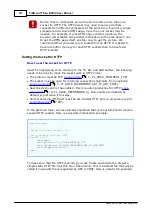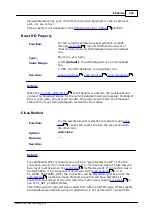
326
Platforms
©2000-2008 Tibbo Technology Inc.
large variable data. For example, HTTP POST methods are routinely used to upload
files to the web server and your device will be able to handle this, too.
So far we haven't touched on the subject of actual data that you will read using
and
. In other words, we haven't
discussed the contents of the VAR buffer. It is time to clear this.
We have already explained that the above R/O property and method will return the
same data, with the only difference that the sock.httprqstring will not actually
remove the data from the VAR buffer and will not be able to access past the first
255 bytes of such data.
Data format in the VAR buffer depends on the method used.
VAR buffer contents -- HTTP GET method
Supposing the client has sent the following request:
GET /form_get.html?
user=CHUCKY&pwd=THEEVILDOLL HTTP/1.1
Host: 127.0.0.1:1000
User-Agent: Mozilla/5.0 (and so on)
The VAR buffer will get everything past the URL and until the first CR/LF. The part
is highlighted in
blue
. There are two variables -- user and pwd. They are equal to
"CHUCKY" and "THEEVILDOLL". Your application can just ignore the "HTTP/1.1"
part.
VAR buffer contents -- HTTP POST method
Here is a sample client request:
POST /form_get.html HTTP/1.1
Host: 127.0.0.1:1000
User-Agent: Mozilla/5.0
(lots of stuff skipped)
Content-Type: multipart/form-data; boundary=---------------------------
21724139663430
Content-Length: 257
-----------------------------21724139663430
Content-Disposition: form-data; name="user"
CHUCKY
-----------------------------21724139663430
Content-Disposition: form-data; name="pwd"
THEEVILDOLL
-----------------------------21724139663430--
336
333
















































